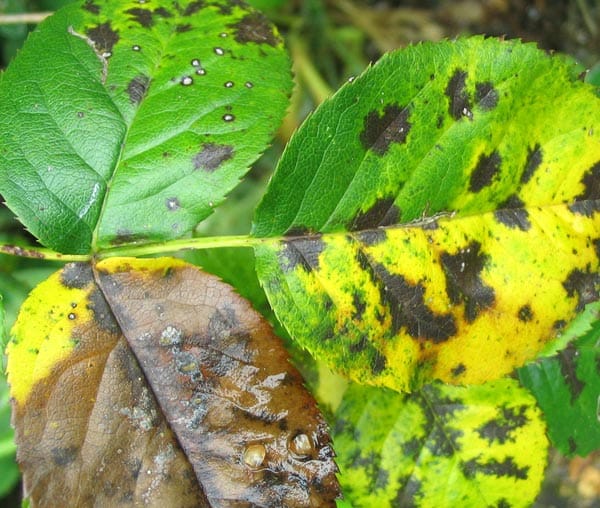Source(s):Nina Eckberg
Identification of Black spot on roses.
Appearance
Black spots 2-12mm in diameter develop on upper leaf surfaces. Leaf tissue surrounding the spots turns yellow and the yellowing extends throughout the leaf. On resistant roses, only tiny black flecks may form and leaves remain green. Raised, purple-red blotches develop on immature wood of first-year canes of susceptible roses.
Hosts
Rose varieties such as teas, hybrid teas, briers and polyanthas are quite susceptible. Rugosa, moss roses and wichuraianas are more resistant to the disease.
SEASON:Leaves are most susceptible while still expanding (6-14 days old). Fungal spores must be immersed in water and continuously wet for at least 7 hours while temperatures are between 70º-80º F.
Damage
When black spot is on a plant, the leaves can begin to fall off. Some plants become completely defoliated, but if cared for,will survive. Black spot lesions on the rose canes are small and seldom kill the plant, but are important in the survival of the disease over the winter.
Integrated Pest Management
Several steps can help control black spot on roses:
- Air circulation around bushes speeds up drying and reduces black spot.
- If possible, do not water plants overhead with sprinklers. Leaves must not be allowed to remain wet or in high humdity for more than 7-12 hours.
- Sanitation is extremely important in controlling black spot. Remove leaves from the ground and prune canes that have lesions to reduce overwintering of the disease.
- Fungal sprays can be used during periods of the year when conditions are favorable for black spot. Preventive spraying can begin in March until leaves are mature, then spray fungicide as needed. Call the Extension Office for the type of fungicides that control black spot and remember, READ THE LABEL of the product you choose.
Comment
If you think you have black spot on your roses, bring in a plant sample to the Extension Office for diagnosis.
Resource(s): Common Landscape Diseases In Georgia
Center Publication Number: 57
- Root Rot on Evergreens - September 23, 2013
- Shot-hole Disease - September 23, 2013
- Gray Mold or Botrytis Blight on Pansies - September 22, 2013
